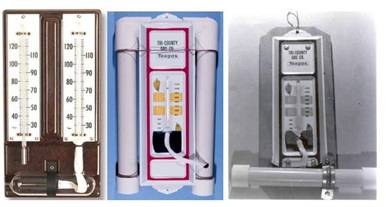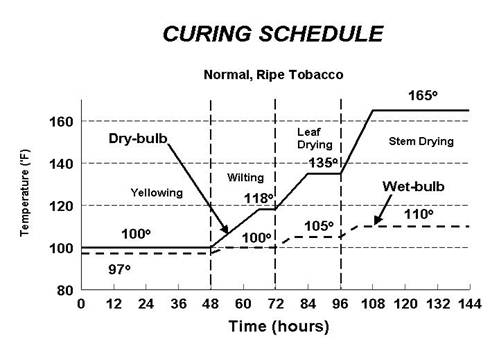Curing Tobacco With Heat Exchangers
Paul E. Sumner
Extension Engineer
University of Georgia
Tobacco curing has been considered an art for many years. Growers today have been taught by their fathers and grandfathers how to turn ripe harvested tobacco leaves to high quality yellow gold cured leaves with good flavor and aroma desired by cigarette manufacturers. With the use of bulk barns, growers today have much more control over the curing process. Management skills include understanding the principles of controlling airflow, temperature and humidity in a controlled environment.
This year the majority of growers will be curing with indirect fired burners. This is a drier heat than curing with direct fired LP burners. Direct fired LP burners produced 1.25 gallons of water for every gallon of LP gas burned. Therefore, moisture levels within the curing barn will not be as high as it has been with direct fired burners with the same vent setting. Growers can monitor the moisture levels within a bulk curing barn by using a wet-bulb thermometer (hygrometer).
Using Wet-Bulb, Dry-Bulb Thermometers
The wet-bulb thermometer measures the temperature of the leaf during the early stages of cure; the dry-bulb thermometer measures air temperature. Most growers use the dry-bulb thermometer, but you also need a wet-bulb thermometer. Since the humidity as well as the dry-bulb temperature must be controlled, a wet-bulb thermometer indicates when adjustments in the vents are necessary. Don't use thermostats as thermometers. They may not be calibrated to sense the same temperatures as thermometers. You can buy wet-bulb thermometers at most fuel supply dealers (i.e. Taylor® Mason's Hygrometer $63.00), or you can make one at a fraction of the cost. A homemade wet-bulb thermometer designed especially for bulk tobacco barns can be used.

Figure 1. Examples of Wet-Bulb Thermometers
Observation and Location
Closely monitor tobacco throughout the curing process for temperature, humidity and color. Look through observation ports regularly to check the wet-bulb, dry-bulb thermometers and color changes taking place. For updraft barns, place the dry-bulb thermometer under the tobacco near an observation port so you won't need to open the door. Place the wet-bulb thermometer between racks or on top of the tobacco for a more accurate indication of wet-bulb temperature. Reverse location of thermometers when using down-draft barns.
Temperature Advance Schedule
There is considerable variance in advancing the temperature depending on the condition of the tobacco. A wet-bulb, dry-bulb temperature schedule (Figure 2) is effective with mature, good quality tobacco.

Figure 2. Bulk Curing Schedule for Mature, Ripe Tobacco.
Humidity
During the yellowing and leaf-drying phases, humidity control is essential. The relative humidity drops as the cure advances. Control the humidity by adjusting the fresh air exchange rate with the vent system. By controlling the humidity, the coloring time may be extended or shortened to get the most desirable color. If the tobacco is drying too fast (drying before yellowing), close the vents. On the other hand, opening the vents will speed drying.
The relationship between the wet-bulb and the dry-bulb temperatures determines the relative humidity within the barn, The closer the wet-bulb temperature is to the dry-bulb temperature, the higher the relative humidity, The relative humidity within the barn determines the leaf's rate of drying. The lower the humidity, the faster the leaf dries; the higher the humidity, the slower the leaf dries. Maintaining the proper wet-bulb temperature not only results in the best possible cures but also minimizes the amount of fuel needed to cure the tobacco.
Advancing Temperatures during Yellowing
Advancing the dry-bulb temperature and wet-bulb temperature in relation to each other is a critical feature of curing. When starting a barn close air Intake vents before the heater is turned on. Turn the heater on and raise the temperature to the yellowing range (Figure 1 ) gradually. Don't raise the temperature more than 5°F at anyone time. Allow about 30 minutes between temperature rises so curing air can become equalized.
Yellowing Considerations
Curing each barn of tobacco as the season progresses requires adjustments in the curing schedule. For example, tobacco grown under varying climatic and field conditions calls for different yellowing schedules with dry-bulb temperatures varying from 95° to 105°F and wet-bulb of 93° to 97°F.
Length of Time Required for Yellowing
Normal tobacco is yellowed at varying lengths of time, depending on the stalk position. You can improve the quality of certain varieties by extending the yellowing period. Certain varieties may sometimes yellow before starch converts to sugar. When this happens, the result may be pale, slick, immature tobacco.
Other Yellowing Suggestions
Remove as much moisture as possible during the yellowing phase of curing. With good tobacco, as much as 20 percent of the moisture can be removed during yellowing. When the yellowing phase is almost completed, the tobacco should show a good yellow color at the leaf tip with slight green-tinged colors running along the main stem and veins to the butt. The leaf tips and edges should begin to tuck and dry to a bright yellow.
When the tobacco throughout the barn reaches the desired color, increase temperature and rate of drying. At the end of yellowing, some wilting should have occurred. Avoid flash temperatures that can dry the leaf before yellowing is completed. This sets an undesirable green color.
Wilting
Some wilting occurs before the end of yellowing at the 105°F dry-bulb temperature, but most of the wilting should take place as the dry-bulb temperature advances from 110° to 118°F. The rate of temperature advance from 105° to 110°F should be 1° to 1.5°F per hour and wet-bulb of 100°F. During the wilting phase, the tobacco loosens considerably and the air can move through readily.
Do not advance the temperature beyond 118°F dry-bulb temperature until wilting is 100 percent complete.
Leaf Drying
When the tobacco leaves have reached the desired yellow color and are thoroughly wilted, the leaf must be dried. The drying stage is critical because tobacco is sensitive to temperature change. Impatience to capture a good color often results in advancing the temperature too rapidly and producing a browning or barn scald. If the temperature is advanced too slowly, sponging may occur.
There must be positive control of airflow and temperature during leaf drying to prevent undesirable color in the cured leaf. To prevent sponging, dry the leaf as rapidly as possible, but not so rapidly as to cause scalding.
Wet-Bulb and Dry-Bulb Temperatures
Maintain the wet-bulb temperature near 100°F during leaf drying. Once the tobacco is dry enough (30-40 percent of the moisture removed) to take dry-bulb readings above 135°F, the wet-bulb temperature is not critical to the quality of the cured leaf. Maintaining a wet-bulb temperature of 110°F or higher, however, tends to conserve fuel.
Stem Drying
Advance the dry-bulb temperature from 135° to 165°F at a rate of 2° to 3°F per hour. Close vents gradually during stem drying. Maintain a vent opening to hold wet-bulb temperature down to 110°F during the first 12 to 18 hours of stem drying. Vents are usually closed completely about the time the leaf is completely dry and the temperature has reached 165°F . Stems should be killed out at a temperature of 165°F. Sugar caramelization will cause tobacco to turn red when the dry-bulb temperature is more than 165°F .
The University of Georgia and Ft. Valley State College, the U.S. Department of Agriculture and Counties of the state cooperating. The Cooperative Extension Service offers educational programs, assistance and materials to all people without regard to race, color, national origin, age sex or disability. An Equal Opportunity/affirmative Action Organization Committed to a Diverse Work Force. Miscellaneous Publication ENG01-003- June 2001
Issued in furtherance of Cooperative Extension work, Acts of May 8 and June 30, 1914, The University of Georgia College of Agriculture and the U. S. Department of Agriculture cooperating.
Gale A. Buchanan, Dean and Director
